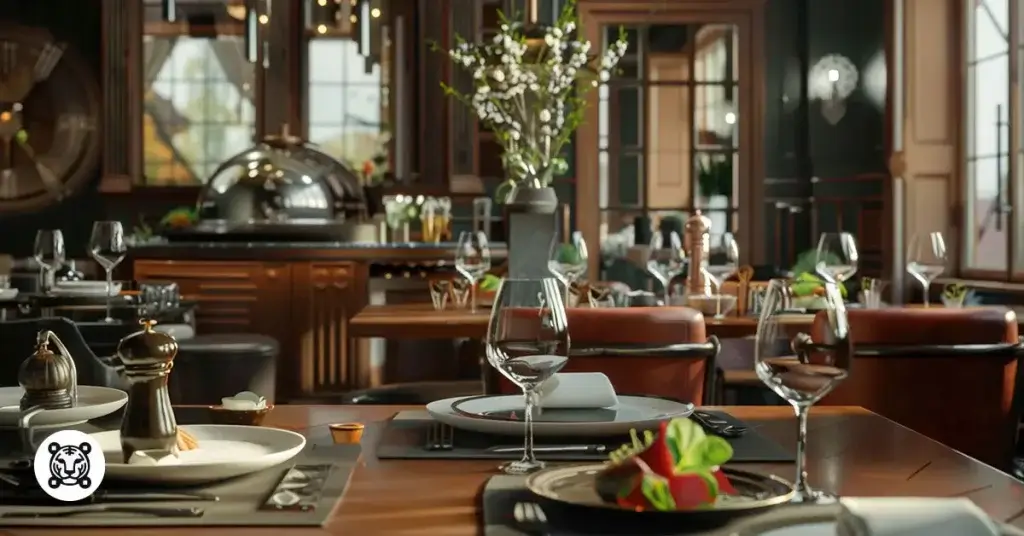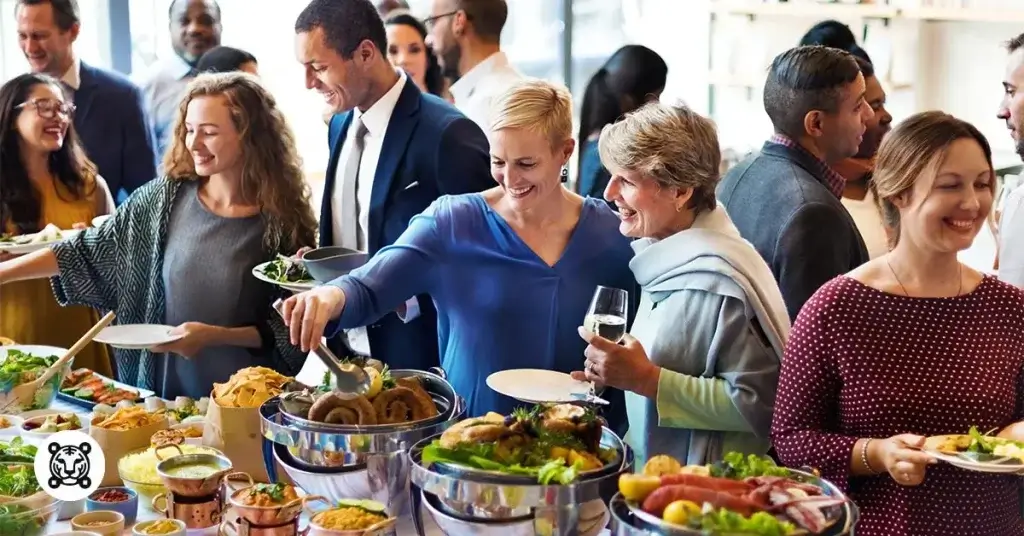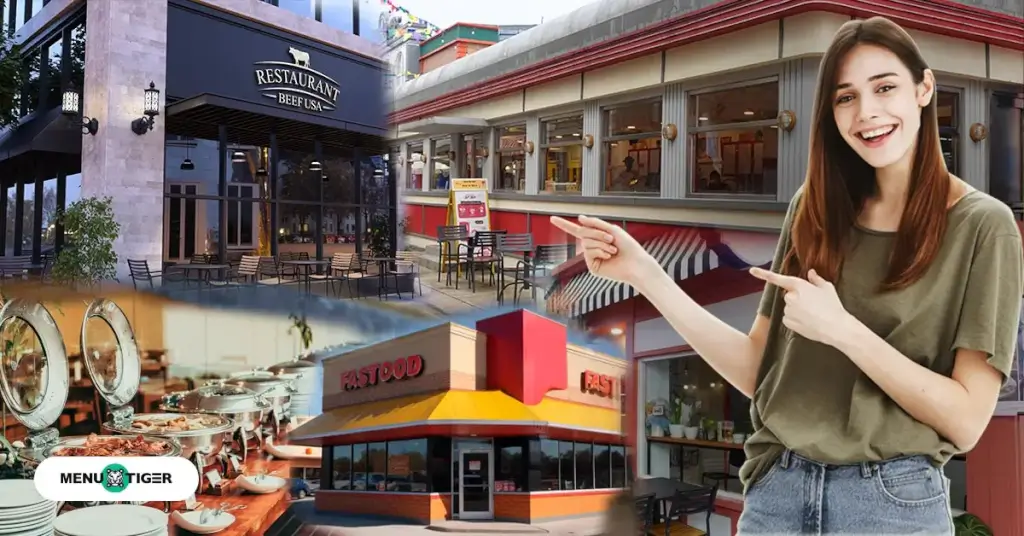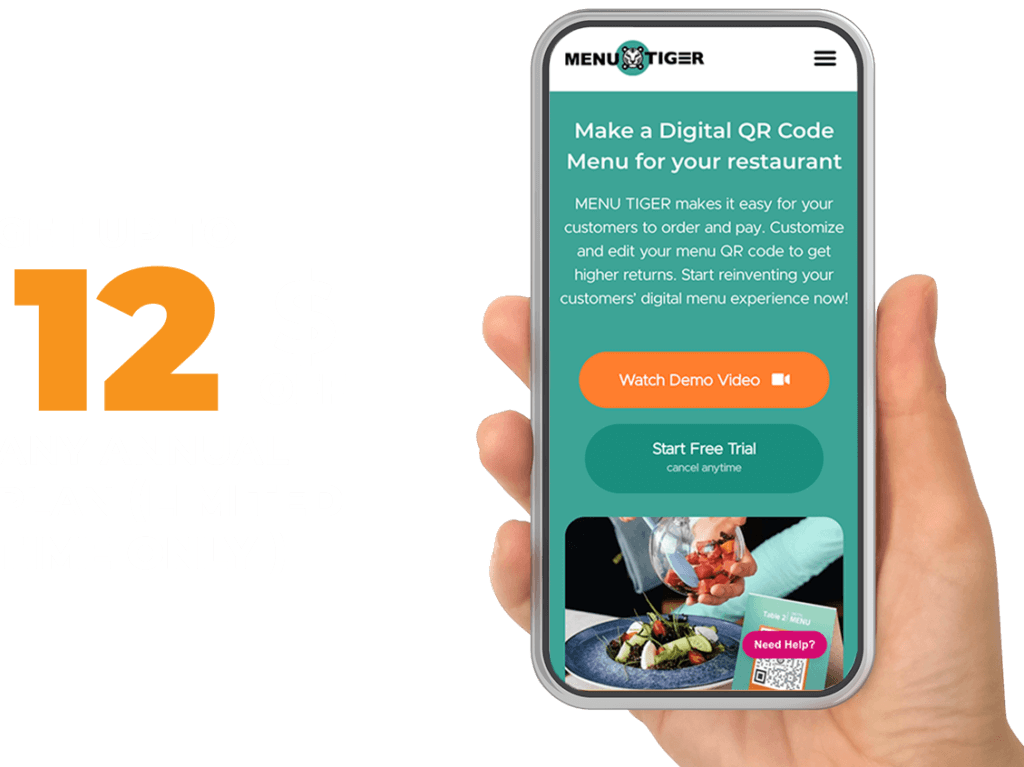There are many different types of restaurants. Whether it’s a cozy café where friends get together or a roadside food truck, dining units surely add life to our culinary culture.
CBS News reports that around 56% of American adults munch out at least once a week.
With such a high demand for eating out, now is the perfect time to fulfill your dream of becoming a restaurateur.
Modern restaurant tools, like the convenience of a QR code menu, further streamline operations. This makes it easier than ever to run a high-selling eatery.
So, read on for a detailed list of the different restaurant types and launch the idea that best suits your vision.
Table of Contents
Toggle5 popular types of restaurants
Fast Food Restaurants

If you ask people what comfort food is, fast food will be the first thing they may think of.
As the name suggests, “fast food” restaurants are all about serving food quickly, usually taking 55 seconds to 30 minutes.
These establishments deal with a standardized menu, where most ingredients are precooked or frozen, hence the quick turnaround time.
Due to the speed of serving, quick service restaurants generally focus on simple and quick dishes like sandwiches, burgers, and fries.
For restaurant owners and managers, fast food eateries have higher profit margins than other restaurant types — at around 6-9%.
The reasons for this skyrocketing profit range may include:
- No expenses for full-service dining, like flatware, dinnerware, or ambiance.
- No advertising costs due to the brand name and identity of the parent chain.
- No expensive cooking tools; flat-top grills, microwaves, and deep fryers do the job.
- No need for huge dining spaces, which means lower rent and utility costs.
Besides, fast-food restaurants earn thousands of dollars from soft drink sales, which are their biggest cashcow. These are sold at a 90% profit margin.
The quick-service restaurant industry is famous for three things: convenience, affordability, and the “grab-and-go” factor offered by trained staff, ordering kiosks, and food ordering software integration.
These promising attributes have earned the industry a market value of around $978 billion in 2023. With popular franchise chains like KFC, Subway, and Burger King leading the way, this figure is only expected to rise further.
For aspiring entrepreneurs, fast food chains are among the cheapest franchises to open, making them an attractive option for those looking to break into the restaurant business with a proven model and strong brand recognition.
Fast food establishments’ popularity comes partly from the sense of familiarity they infuse in potential customers. After all, McDonald’s fries will taste the same in Chicago and Los Angeles.

Casual Dining Restaurants

Casual dining restaurants have a little more upscale ambiance than fast-food eateries. This is due to their pleasant and laid-back vibe.
These restaurant types mostly have a table service, where guests are served by the waitstaff.
Unlike fast-food restaurants, where you can grab burritos and burgers on the go, fast-casual dining units feature larger menus with appetizers, salads, and sides.
While you won’t find trendy decor and experimental cuisine at these restaurants, the ambiance is comfortable enough to relax after a hectic workday.
Fast casual restaurants have moderately priced items, and you’ll often see promos like coupon campaigns and happy hour deals. High chairs, kids’ menus, and sometimes even play areas are common.
Fine Dining Restaurants

If you think of an upscale dining interior with multi-course meals, fine dining is the one for you. They have stylish decor made of fine wood, marble, or plush fabrics.
Plus, the lighting is usually warm and romantic to suit the ambiance well.
As the fanciest of all restaurant models, fine dining establishments have an à la carte menu of dishes you won’t eat regularly.
Staples include trendy entrees and wine lists — think foie gras, plank salmon, or steak tartare.
Everything at a fine dining eatery is decided with care, from the food presentation to the decor and table settings.
Customers mostly visit these eateries to celebrate milestones (birthdays or anniversaries). In other words, they don’t have recurring customers.
Therefore, the goal for restaurateurs is to earn as much as they can from a single visit. This is why these restaurants have a pricier menu.
The plates are artfully arranged, and even the most minor details, like the garnish or the cutlery items, are chosen with care.
These types of restaurants have an exclusive feel that speaks of class and elegance. After all, fine dining is all about luxury and elegance.
Cafés and Coffee Shops

Cafes and coffee shops are the heartbeat of many neighborhoods. They bring warmth and liveliness to plain old streets and have become a staple in consumers’ routines.
The coffee giant Nescafe states that 80% of consumers buy their morning caffeine fixes at least once a week.
Additionally, 51% of people buy coffee at coffee shops on a weekly basis.
With the rise in social distancing and hybrid working models, many people use cafés as third working spaces. Employees get together over a cup of cappuccino, sharing common interests and hobbies.
Research shows that almost half of all remote workers now work from cafes. The trend of “laptop workers” in co-working spaces is only expected to rise.
Here are other characteristics of cafés and coffee shops:
- Menu: Beverages and light bites like pastries, muffins, croissants and sandwiches
- Service Style: Drive-thru and/or counter service with stations for milk and sugar
- Atmosphere: Small interior space with soft background music and warm decor
- Work-Friendly: Free Wi-Fi and many power outlets; good for remote work
- Examples: The Coffee Bean & Tea Leaf, Tim Hortons, Starbucks
Buffet Restaurants

Buffets are lauded for their family-friendly style, letting customers refill their dishes as many times as they want, only for a flat cost.
Operating on an all-you-can-eat model, these restaurant types have self-service stations instead of the usual “sit and order” approach.
Since there’s no table service, running a buffet means you need less waitstaff, leading to a faster customer service time.
Many buffet restaurants also host themed sections, like seafood buffets, barbecue corners, or international cuisine days. This way, you can enjoy lots of delicious dishes without worrying about portion sizes or the cumulative bill.
For restaurateurs, buffet restaurants have a thin profit margin. However, the daily sales make up for it during high-traffic days, like Christmas and birthday celebrations.
MENU TIGER: The perfect QR code menu solution for restaurants

Launching a restaurant business takes a huge investment, from strategic planning and marketing to lease and training costs.
This translates into a financial challenge for potential restaurant owners, leaving them struggling to maintain smooth operations.
That’s why it is crucial for restaurant managers to have an all-in-one QR code menu software, like MENU TIGER.
It takes the heavy burden off your shoulders by managing and updating your menu from a single centralized dashboard, streamlining restaurant services. Let’s see what it offers.
Easy-to-update QR code menu
In the restaurant industry, all that sparkles is considered gold. Therefore, the better you present your offerings, the more likely your customers are to order.
A user-friendly digital menu QR code is your best ally in this regard, as it helps restaurants digitally present their dishes in a beautiful manner.
You can place the QR code in different areas. These may include tables, counters, posters, or anywhere customers can easily scan it.
If they know how to scan a menu QR code, they will be taken to the restaurant’s digital dashboard.
Here, they can view your menu, place orders, and even make payments — all from their smartphones. No more wait queues and order requests, just a quick and seamless ordering process.
Sales and menu analytics
Without sales and menu analytics, restaurant owners would never know if their units are turning a promising profit or closing at break even.
But don’t worry. With MENU TIGER, you get all the juicy insights behind your restaurant’s performance.
From ingredient usage and peak hours to customer preferences, this comprehensive dashboard represents all the KPIs you need for success.
Using these analytics, you can then adjust your operations for maximum profitability.
Branding and feedback
Besides being an interactive restaurant menu software, MENU TIGER also allows you to create a consistent brand identity.
Whether you have red restaurant themes or a white-colored layout, you can make your dashboard look right like your restaurant does. Make the digital menu truly yours by adding your establishment’s logo, color scheme, and designs.
Statistics from eMarketer show that 98% of customers read online reviews before making a decision. This reflects the power of customer reviews.
But who has the time to fill out manual surveys in today’s digital age? This is where the MENU TIGER feedback feature comes in, which allows restaurateurs to collect reviews on the go.

Launch a successful food service establishment with MENU TIGER
Whether you plan to launch a fine dining establishment or a roadside food truck, MENU TIGER is what you need for the types of restaurants’ success.
The platform features a smooth, user-friendly digital restaurant menu QR code that helps restaurants update menus, prices, and descriptions in real-time, reducing wait times and long queues.
Thanks to the analytics feature, restaurateurs can also monitor their unit’s progress and make timely decisions for growth and profitability.
So sign up now and streamline your restaurant’s operations and customer service!
FAQs
Ghost restaurants don’t have a physical dining space for customers. These food service establishments usually run on a food delivery model. The customer places an order online, and the food is delivered through delivery services. This means there’s no need for furniture, decor, and maintenance expenses of a traditional restaurant.
Food trucks are mobile restaurants. They operate on large motorized vehicles like trailers and vans. Food trucks cook, store, and serve food. Also known as restaurants on wheels, these mobile restaurants are super convenient and cost-friendly to open and run. This is because the food truck startup costs are lower than traditional restaurants, cutting down on rent, utilities, taxes, and decor expenses.





